Bed Bugs in Your Home? Here’s How to Spot, Treat, and Prevent Them

Bed bugs—just the mention of them can make your skin crawl. These tiny, blood-sucking pests are one of the most dreaded household infestations, and for good reason. They’re hard to spot, even harder to eliminate, and can quickly spread from room to room if left untreated.
If you’re wondering whether you have bed bugs, or if you just want to be proactive about keeping them out, this comprehensive guide will show you how to spot, treat, and prevent bed bugs in your home.
What Are Bed Bugs?
Bed bugs are small, wingless insects that feed on human and animal blood—primarily at night. Adults are about the size of an apple seed (5–7 mm), reddish-brown, flat, and oval-shaped. After feeding, they swell and become more reddish in color.
They hide in tiny cracks and crevices, especially near beds, couches, and baseboards. While they don’t transmit diseases, their bites can cause itching, allergic reactions, and psychological stress.
How to Spot Bed Bugs in Your Home
Bed bugs are elusive. They don’t build nests or leave visible trails like ants or mice, and they can live for months without feeding. But there are clear signs to watch for:
1. Bite Marks on Your Skin
Bed bug bites often appear in small clusters or rows, usually on exposed skin such as the:
-
Arms
-
Neck
-
Legs
-
Back
The bites are red, itchy, and can resemble mosquito bites. However, not everyone reacts the same way—some people don’t show any visible reaction at all.
2. Tiny Blood Stains on Sheets or Pillowcases
After feeding, bed bugs may leave behind tiny red or rust-colored spots—either from crushed bugs or their droppings.
3. Dark Fecal Marks
You may find small black or brown dots (about the size of a pen tip) on mattresses, box springs, headboards, or wall corners. These are fecal spots and one of the most reliable signs of infestation.
4. Bed Bug Shells or Skins
As bed bugs grow, they shed their exoskeletons. Look for light brown, translucent shells around mattress seams, furniture, and electrical outlets.
5. Musty Odor
In heavy infestations, bed bugs can produce a sweet, musty smell, often compared to overripe raspberries or coriander.
If you notice any combination of these signs, it’s time to act quickly.
How to Treat a Bed Bug Infestation
Eliminating bed bugs takes time and thoroughness. While DIY methods can help in mild cases, a professional pest control service is often required for full eradication.
Here are the most effective treatment methods:
1. Heat Treatment
Bed bugs can’t survive temperatures above 120°F (49°C). Professional heat treatments involve raising the temperature in your home to lethal levels for several hours.
Pros:
-
Extremely effective
-
Kills bugs and eggs at once
-
No chemical residue
Cons:
-
Expensive
-
Requires professional equipment
-
You’ll need to vacate your home temporarily
2. Vacuuming & Deep Cleaning
Thorough cleaning is critical to reduce bed bug populations.
Steps:
-
Vacuum mattresses, box springs, and furniture thoroughly
-
Use a crevice tool to reach corners and seams
-
Dispose of vacuum bags immediately in a sealed plastic bag
-
Wash all bedding, linens, and clothing in hot water and dry on high heat
Important: This won’t eliminate an infestation on its own but helps reduce the spread.
3. Chemical Insecticides
Several EPA-approved insecticides target bed bugs, including:
-
Pyrethroids and pyrethrins
-
Neonicotinoids
-
Desiccants (which dry out and kill bugs)
These chemicals can be effective but must be applied correctly and safely.
Warning: Bed bugs in some areas have developed resistance to common pesticides, so results may vary.
4. Encasements for Mattresses and Box Springs
Bed bug-proof encasements trap any bugs inside and prevent new ones from entering. These are zippered covers designed specifically for mattresses and box springs.
Use encasements after treatment to prevent re-infestation.
5. Professional Pest Control Services
If DIY treatments don’t work—or if you’re dealing with a large or recurring infestation—hire a licensed pest control expert.
Benefits:
-
Access to commercial-grade treatments
-
Professional inspections to locate all hiding spots
-
Follow-up treatments as needed
-
Guaranteed results in most cases
How to Prevent Bed Bugs from Coming Back
Even if you’ve never had bed bugs before, taking preventive steps can save you a lot of trouble in the future.
1. Be Cautious When Traveling
-
Inspect hotel mattresses and headboards before unpacking
-
Keep luggage off the floor—use racks or place in the bathtub
-
When returning home, wash all travel clothes in hot water and inspect your suitcase
2. Inspect Second-Hand Furniture
Never bring used mattresses, couches, or upholstered chairs into your home without a thorough inspection. Bed bugs can hide deep inside and remain undetected for weeks.
3. Use Protective Covers
Invest in bed bug-proof encasements for your mattress and box spring. These not only prevent infestations but also make future inspections easier.
4. Reduce Clutter
Bed bugs love to hide in cluttered areas. Keeping your bedroom and living spaces clean and organized makes it harder for them to settle in.
5. Seal Cracks and Gaps
Seal any cracks in baseboards, walls, or around outlets. Bed bugs can move between rooms or apartments through tiny openings.
Final Thoughts
Bed bugs are a growing problem in homes, apartments, hotels, and even office spaces. Early detection and fast action are the keys to controlling an infestation before it becomes severe. By knowing what signs to look for—and how to treat and prevent bed bugs—you can protect your home and your peace of mind.
If you suspect bed bugs in your home, don’t wait. Contact Bug Buster Gold Coast today for a free inspection and customized treatment plan. Our certified technicians are experienced in detecting, eliminating, and preventing bed bug infestations—so you can sleep soundly again.







